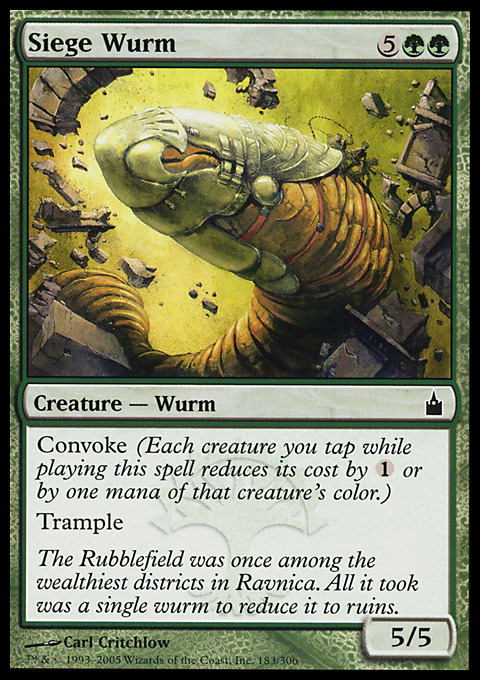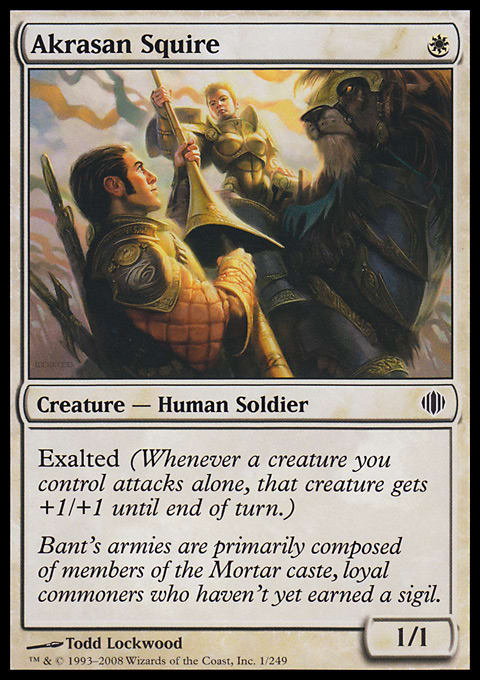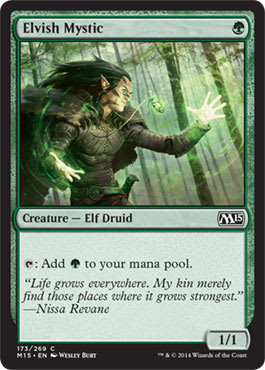The reason is that my Cube is made up exclusively of commons. While Magic design can adjust the dials on colors at higher rarities, commons tend to expose the purest possible essence of a given color. Mechanics might appear on the cards that appear more frequently, but these are hardly the most exciting or powerful executions of new devices in the toolbox. In turn, commons heavily tied to their settings tend to feel similar to cards from any other set. Take Siege Wurm as an example. The Magic 2015 Limited standout is a quintessential green card that operates along a well-worn axis: large creature with trample. Convoke can do some interesting things at higher rarities, but at common, it can only help execute the known.
Because of this, Pauper Cubes will also tend to follow these paths. Given a singleton restriction, it becomes challenging to build a mechanic-based deck in a Cube. Instead, colors—and color pairs—become historical executions of their inherent themes and tropes.
And that circles back to Selesnya and Simic. These two-color combinations are last by virtue of the alphabet, but they also presented issues as I revamped and crafted my Cube.
Selesnya
Selesnya takes green’s love of big creatures and slams it together with white’s love of small, organized fighting forces. This leads to a combat-oriented and monster-heavy guild. There is also a distinct history of the little-kid style of play evident in this pairing’s past as evidenced by recent adventures in Vintage Masters. I find that the best Selesnya decks partner the excellent creatures in these colors with the combat tricks and removal in white.
Every shape and size – The creatures in Selesnya tend to fall between 1 and 5 on the mana curve. 1-drops are almost always white with battle-oriented abilities (like Akrasan Squire), while the end of the curve by 4 and 5 are almost always green (with the likes of Rumbling Baloth). Selesnya decks should be stocked at every possible casting point. The color roles can easily be reversed, with green providing Nettle Sentinel and Elvish Mystic and white sending up Supply-Line Cranes.
Dodge, duck, dip, dive, dodge – The grounds tend to become clogged up, so Selesnya seeks ways to push damage through regardless. While white’s corps of evasive creatures like Apex Hawks and Stormfront Pegasus are obvious choices, green needs the unwritten keyword of “big” to eventually push past blockers. Protection effects also shine in Selesnya, with Benevolent Bodyguard lagging only behind Aven Liberator in that department. These two apply their own pressure, protect a huge threat, and can force through the last points of damage.
Enhance . . . enhance . . . enhance . . . – Typified by Armadillo Cloak and Rancor, Selesnya has the best tools to make one giant monster. Coming off Theros-block Limited, the idea of going tall rather than wide should be familiar to those who frequent the Draft tables. The aforementioned Auras and counter-focused cards such as Common Bond and Burrenton Bombardier can not only win a combat, but also increase the potency of a given threat. This strategy works best in this pairing due to the previously discussed protection effects and Vines of Vastwood.
Akrasan Squire, Qasali Pridemage, and Trusted Forcemage are fine creatures in their own right. In the going-tall deck, they are doubly dangerous to help turn a creature into the one true threat.
Go sit in the corner – Finally, Selesnya leans heavily on white’s removal. While all the instant-speed variety options work just fine, the Aura-based removal spells are the ones this deck craves. Selesnya wins by continuously applying pressure and through the ability to spend all available mana on its turn to remove a threat and further develop a board—thus keeping the opponent on the all-important back foot. Judge Unworthy might be the best possible instant-kill spell in this deck since it is cheap and makes use of green’s higher casting costs. Simian Grunts also works just fine, as it usually eats an attacker and then cracks back for 3. Good times.
Selesnya Aggro ? Pauper Cube | Alex Ullman
- Creatures (18)
- 1 Aven Liberator
- 1 Benevolent Bodyguard
- 1 Burrenton Bombardier
- 1 Centaur Healer
- 1 Drudge Beetle
- 1 Elvish Mystic
- 1 Hungry Spriggan
- 1 Kabuto Moth
- 1 Kor Hookmaster
- 1 Kor Skyfisher
- 1 Nest Invader
- 1 Nettle Sentinel
- 1 Nyxborn Wolf
- 1 Rumbling Baloth
- 1 Simian Grunts
- 1 Supply-Line Cranes
- 1 Trusted Forcemage
- 1 Squall Drifter
- Spells (5)
- 1 Leeching Bite
- 1 Righteous Blow
- 1 Sigil Blessing
- 1 Arrest
- 1 Pacifism
And that’s a relatively standard Selesnya beatdown list. Decks in this vein want to curve out and leverage their tricks to apply pressure and as a form of card advantage. Overextending can be problematic since it does not have a way to recoup lost cards, so the best plan sometimes is to flood the board and overwhelm the defenses.
Selesnya Auras ? Pauper Cube | Alex Ullman
- Creatures (17)
- 1 Akrasan Squire
- 1 Apex Hawks
- 1 Aura Gnarlid
- 1 Aven Liberator
- 1 Benevolent Bodyguard
- 1 Deadly Recluse
- 1 Hopeful Eidolon
- 1 Knight of Sursi
- 1 Leafcrown Dryad
- 1 Llanowar Empath
- 1 Qasali Pridemage
- 1 Seraph of Dawn
- 1 Stormfront Pegasus
- 1 Totem-Guide Hartebeest
- 1 Wandering Wolf
- 1 Wickerbough Elder
- 1 Wingsteed Rider
- Spells (6)
- 1 Rebuke
- 1 Sunlance
- 1 Armadillo Cloak
- 1 Faith's Fetters
- 1 Pacifism
- 1 Rancor
- Lands (17)
- 8 Forest
- 8 Plains
- 1 Selesnya Sanctuary
Playing with enchantments is more of a niche strategy—at least in my Cube. While it’s a viable option, many things have to go right for the deck to come together. Aura Gnarlid and Wandering Wolf are excellent targets for modifications, as they can go by blockers with greater ease.
Simic
At last, we have arrived at Simic. While I self-identify as Golgari, I have an affinity for those who dwell in the Tropical Islands as well. Pairing green and blue in the past has required leaning on very powerful cards. G/U Madness in Vintage Masters is one such example—the archetype needed a critical mass of cards to function, often multiples of key players. In actuality, green and blue often rely on this critical mass for Draft decks. Gatecrash focused on maximizing evolve, and self-mill in Innistrad was the realized dream of going deep.
Cubes do not always have this flexibility, especially when adhering to the saying “there can be only one.” Therefore, in order to make Simic an option, a designer will need to examine the constants.
So, what are they?
Ramp – Green almost always has access to a 2- or 3-mana spell that pulls a land out of the library and puts it directly into play, usually tapped. Rampant Growth is the hallmark of this effect, but Cultivate and Search for Tomorrow may be more powerful. This allows green to jump to a late point on the casting curve and land its bigger threats faster. Green also has mana dorks—Elvish Mystic and its ilk—to accomplish the same task.
Big creatures – Forest denizens also have access to the largest monsters at common. Not only that, but thanks to ramp, they can come out ahead of schedule. A successful Simic deck would have to leverage these two aspects of green to great effect. This means finding a way to force damage through while also protecting these wonders of nature.
Bounce – A variant of Unsummon is at home in every set. These cards are ideal for clearing the way for green’s ground-pounders. They can also be used as a form of removal if someone decides to get tricky with a stack block. Bounce becomes better when it comes attached to a creature, so Man-o'-War and Mist Raven are high picks. Aethersnipe also is at home in Simic since it is expensive enough that it wants to be paired with ramp.
Card-draw – Every blue deck wants this style of spell. Since the vast majority of cards in the Cube are of a similar power level, drawing more of them helps to tip the scales in your favor. Accelerating on mana and pairing it with card-draw is potent since this increases the ability of the deck to cast more of those recently peeled spells.
Simic, therefore, is like the greatest hits of green and blue. Rather than be multiple archetypes, it is an amorphous deck that makes the best use of the color with the best spells and its partner with the best creatures.
Simic ? Pauper Cube | Alex Ullman
- Creatures (15)
- 1 Aethersnipe
- 1 Civic Wayfinder
- 1 Deadly Recluse
- 1 Frost Lynx
- 1 Invasive Species
- 1 Krosan Tusker
- 1 Llanowar Elves
- 1 Mist Raven
- 1 Nessian Asp
- 1 Nest Invader
- 1 Nimbus Naiad
- 1 Omenspeaker
- 1 Sentinel Spider
- 1 Shaper Parasite
- 1 Shimmering Glasskite
- Spells (8)
- 1 Repulse
- 1 Symbiosis
- 1 Compulsive Research
- 1 Prey Upon
- 1 Rampant Growth
- 1 Silent Departure
- 1 Flight of Fancy
- 1 Bonesplitter
- Lands (17)
- 8 Forest
- 8 Island
- 1 Simic Growth Chamber
Straightforward and powerful, this Simic deck wants to pull out ahead of an opponent and stay there. While it may not look like much, Simic decks are often far greater than the sum of their parts. If there is any pairing I would like to better define, it is this one. If you have thoughts, let me know in the comments.
So here we are: at the end of the road. All ten guilds have been covered, but these are just some ways to play them in Cube. The entire history of Magic allows this models to shift with tuning and tweaking. While Pauper Cubes may stick to these themes, there’s no reason others can’t explore. What are some of your favorite off-color strategies? Love Green Skies? How about Red Control? Cube is the place to explore these ideas because it is the playground of imagination, and imagination is limitless.





























